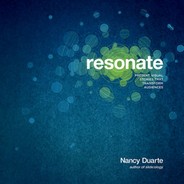
226 Resonate
The presenter is the public persona of a single individual,
but in reality, the best presentations result from the
collaborative efforts of an empowered team behind
the scenes.
Alfred Hitchcock controlled the central creative aspects
of his films, but he relied heavily on his team in their cre-
ative development and production. Ideas were written
and drawn before they were filmed. Hitchcock worked
with a screenwriter to develop a written framework (the
script). He then worked with a production designer to
create a visual framework (sketches and storyboards).
2
Written Framework:• To Hitchcock, the real creative
work on a film took place in the office of the writer.
“We went into a huddle and slowly from discussions,
arguments, random suggestions, casual desultory talk,
and furious intellectual quarrels as to what such and
such a character in such and such a situation would or
would not do, the scenario began to take shape.”
3
Without a doubt, Hitchcock brought out the very best
in his writers. They created absorbing stories, devel-
oped interesting characters, and provided compelling
dialogue. Combined with Hitchcock’s direction, the
result was a body of work unmatched in the cinema.
4
Visual Framework:• Hitchcock constantly visualized
his movies. He began with a story or idea and moved
quickly to develop a look for the film. Each step in
the process—costume design, production design, set
design, visual effects, written scene descriptions, shot
lists, storyboards, and camera angle drawings—included
a conversation with the appropriate department heads.
Hitchcock’s collaborators usually took one of the direc-
tor’s suggestions and expanded upon it, integrating their
ideas into the collective process. Hitchcock envisioned
Case Study: Alfred Hitchcock
Be a Collaborative Visionary
his films in detail before the camera began to roll.
5
When
interviewed by French film director Francois Truffaut in
1962, Hitchcock boasted, “I never look at a script while
I’m shooting. I know the whole film by heart.”
6
Actress Janet Leigh described his modus operandi: “In
his mind, and sketched on the pages of his script, the
film was already shot. He showed me the model sets
and moved the miniature camera through the tiny fur-
niture toward the wee dolls, exactly the way he intended
to do in the “reel” life. Meticulously thorough down to
the minutest detail.”
7
The process of creating a movie is a highly collaborative
one in which each person involved brings a layer of
value. The better we understand the creative process
behind motion pictures, the better we can understand
the creative process behind an effective presentation.
Great leaders honor the people behind the curtain that
help with their presence on stage. Leading requires that
you bring out the best in the team supporting you. Use
their strengths and talents to build on your ideas. Be
open to modifying your vision by embracing the unique
value they bring to the project.
Even though Hitchcock was the one in the spotlight, he
let many others influence his work.
My dad, to whom this book is dedicated, was a
contributor to Alfred Hitchcock’s Mystery Magazine.
I’ve posted his short stories online.
www
CH010.indd 226CH010.indd 226 8/16/10 7:42:38 PM8/16/10 7:42:38 PM

On each film, Hitchcock
meticulously planned out
shots, camera movement, and
even details like the number
of birds in the shot and the
distance of the camera from
the action. Then, a storyboard
artist sketched his vision.
8
Alfred Hitchcock
English Filmmaker and Producer
CH010.indd 227CH010.indd 227 8/16/10 7:42:43 PM8/16/10 7:42:43 PM
..................Content has been hidden....................
You can't read the all page of ebook, please click here login for view all page.
